Poor vision: magnifiers Jayne Kempster, David Kinshuck, Bruce Fisher |
|
Principles of Magnifiers |
Reading is much quicker with weaker magnifiyier, as more words can be seen at one time. If you sight is poor and you need a strong magnifier, reading will be much slower. |
 |
|
 With low magnification there is a large field of view, and many words can be seen at the same time. The lens tends to be larger.   With more magnification, fewer words can be be seen at once. The lens tends to be smaller. |
|
Â
Field of view with high and low power magnifying glasses |
| With most magnifiers the field of view, can be made wider â¦seeing more letters for instanceâ¦. by holding the object or book closer. This can make your arms or neck ache. |  |
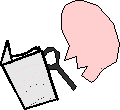 |
 Holding things close to read can be awkward and tiring, especially if a magnifying glass is needed, but more words come into view. |
|
|
|
|

|
Â
Good lighting |
|
Reading with a good light helps. The light needs a reflector so
the light shines on the book, not into your eyes. The light needs to be positioned so there is no glare, reflection, or shadows. If the magnifier is not internally illuminated, a reading light is usually better than a central light hanging down from the ceiling. This is like reading with daylight behind you, but not very bright like sunlight. Some of the magnifiers described here have built in illumination. This can make them larger and more cumbersome, but the extra light can make reading much easier. |
 |
|
|
An anglepoise light is often essential for reading  |
Â
Magnifiers |
|
Magnifiers, often called magnifying glasses, fall into several categories.
They can be either
1.   Spectacle mounted They can have a light inside or on the outside; some are provided with a stand to keep the magnifier still to help produce a large still image. RNIB pages. RNIB resource centre |
 |
Â
Use the good eye |
| With magnification it can become hard to use both eyes together
because your nose gets in the way.
Therefore with more magnification, put the lens in front of your best eye. If you use the right eye only for instance, hold the the object directly in front of your right eye. When you use both eyes hold the object in front of your nose. |
 |
Â
Is it tiring? |
|
Holding a book or sewing 5-6" (15cm) away from the eyes becomes extremely tiring. If you use a "ribbon sling" your hands care supported and it can be more comfortable. This is a piece of ribbon or scarfthat is tied in a loop. Tie the ribbon, and thread each hand through the loops. This takes the weight off your arms and and keeps the right working distance. You need to experiment to find the correct length of ribbon. |
 |
|
|
Â
Hobbies & Interests |
| Different tasks require different degrees of magnification, and
also different types of magnifier. It is therefore important that
your optometrist (or whoever provides your magnifying aids) knows
what you need to do and what your hobbies are.
If you have an unusual hobby, show your optometrist how you like to work. Your optometrist must know the âworking distanceâ: this is the distance from the eyes to the book, newspaper, painting, piano music, or sewing held in your hands etc. |
Â
|
Â
Stand Magnifiers |
|
If greater magnification than 2 x is required, then
hand held magnifiers are usually more versatile.
Stand magnifiers that are internally illuminated
(like a map reader â¦with a light inside) should
be used with standard reading glasses. Â |
 |
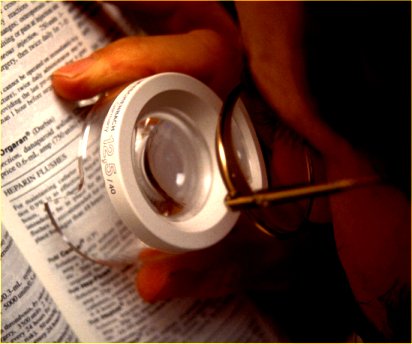 |
A small stand magnifier suitable for reading a telephone directory or bill. This one has a âhigh magnificationâ, but remember only a few words will be visible at one time. These usually give the best results when held near your reading spectacles, and resting it on whatever you are reading. |
|
|
A stand magnifier suitable for reading a letter. This one has a âlow magnificationâ, so many words are visible at one time, but the letters may not be large enough for everyone to read. Â |
Â
How to use a magnifier |
|
There are a many way of using a hand held magnifier, whether illuminated
or not. There are no particular rules, but lighting is critical, even
with an internal light.
As mentioned, if you have one good eye, even if one eye was dominant when you were younger, it is important that you hold things in front of your better eye. This may mean changing habits of a lifetime, which can be very frustrating. |
 |
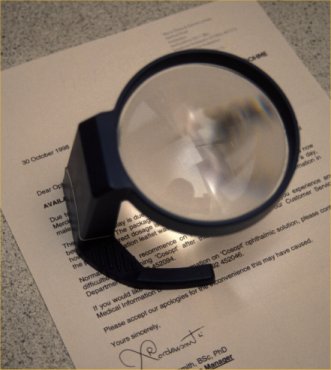 |
An small fixed distance magnifier that is easy to carry around. Good lighting is needed (see text). |
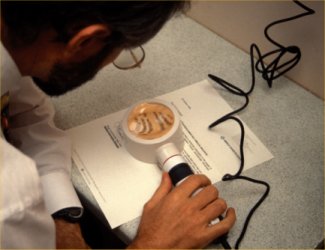 |
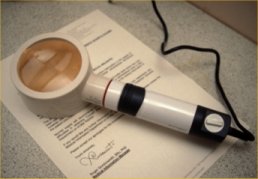 |
|
|
An illuminated fixed magnifier, with batteries
or a transformer that will plug in. These are very popular: close
up picture right |
Â
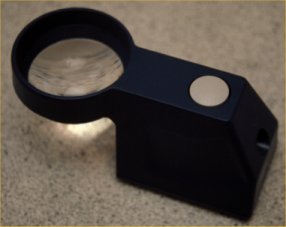 |
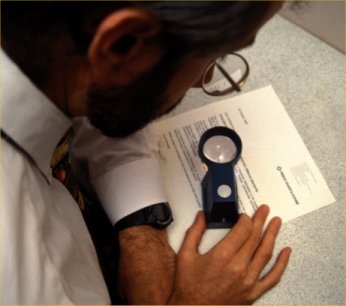 |
|
A small magnifier, very portable. Close up on left, in use on the right. |
|
Â
Large supported magnifier .....floor or wall mounted |
|
An illuminated magnifying glass on a stand resting on the floor. These are expensive but very useful for sewing, hobbies or reading for many people. The sewing is held about 5" (12cm) behind. |
|
| Â |
|
Â
|
Spectacle aids |
|
There are many different types of spectacle aid. They have to be fitted by a specialist Low Vision optometrist or expert. Some use one eye, some use both eyes. Some newer devices use a type of television camera and are electronic and very expensive. If you are aged 85 years, you may not be able to get used to such a device. If you are younger they can be extremely effective. |
|
Â
Monoculars |
| These can be helpful for distance sight, perhaps seeing a lecturer. | Â |
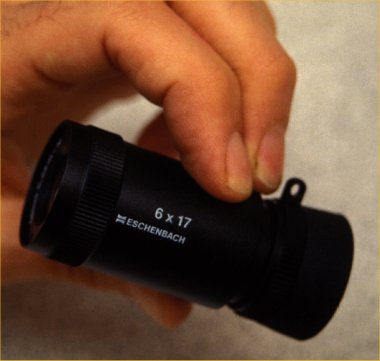 |
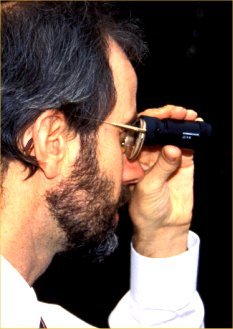 |
|
Monocular telescopes may help in and out of the house. Use with the good eye. |
Â
Good lighting is essential |
This is discussed in detail . When reading, the light should come from behind. A very bright room light may not be helpful..it is better to have a light shining from behind, like an angelpoise light. Such as these (US), UK , UK. These can be very expensive. It would be best to borrow one from a friend and try it out before buying, or ask you low vision specialist to show you them. For walking round the house, good lighting helps, but should not be too bright. |
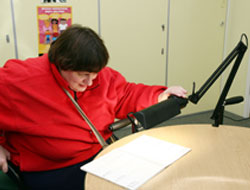 Â
|
Â
Electronic Aids |
As with everything electronic, there are new versions each month, and they are getting cheaper. You really need expert advice from a low vision expert, and there are departments in most eye clinics and outside the clinic , and many optometrists can help.
|
 |
Â
Computerised screen readers |
Again, there are new versions each month, and they are getting cheaper.
|
 |
Â
Suppliers of magnifiers |
|
Â
| The address of this site ('org' changing to 'nhs') is changing from http://www.goodhope.org.uk/departments/eyedept/ to http://www.goodhope.nhs.uk/departments/eyedept/ |
|